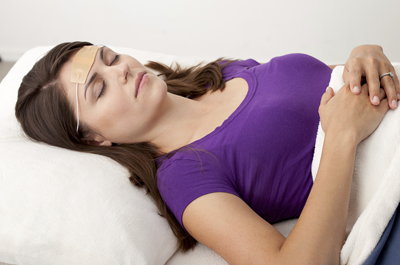Neuromodulation Tool May Help Overcome Refractory PTSD, Depression
Abstract
Preliminary research is showing that an approach called external trigeminal nerve stimulation can improve symptoms of comorbid depression and PTSD in patients who are not responding to medication.
The results of several small pilot studies suggest that brain stimulation delivered via a small electric patch placed on the forehead may one day help augment pharmacotherapy in people with comorbid posttraumatic stress disorder (PTSD) and depression.

Early clinical work shows that stimulation of the trigeminal nerve during sleep leads to depressive symptom improvements in people not responding to medication.
While the new technology—known as external trigeminal nerve stimulation (eTNS)—has been evaluated in only a small number of patients, the authors of a paper that appeared in the February issue of Neuromodulation: Technology at the Neural Interface said the mood improvements following eight weeks of treatment with the device suggest that it might be an effective adjunct for patients with difficult-to-treat psychiatric illness.
eTNS, which sends a low-level current from a patch worn on the forehead to the trigeminal nerve as a patient sleeps, was initially developed at the University of California, Los Angeles (UCLA), as a method for treating drug-resistant epilepsy. (The trigeminal nerve is responsible for transferring signals between the face and the brain.) As the researchers were evaluating the technology in preliminary studies with patients, they noticed that in addition to improvements in epilepsy symptoms, the patients experienced improvements in mood.
This piqued the interest of Ian Cook, M.D., and Andrew Leuchter, M.D., in UCLA's psychiatry department.
“It made sense, as the trigeminal nerve feeds into the major centers for mood and anxiety in the brain like the amygdala,” said Leuchter, who is director of the neuromodulation division at UCLA’s Semel Institute for Neuroscience and Human Behavior. He and colleagues began testing eTNS in patients with depression to see whether they could also benefit from the technology.
In 2013, Leuchter’s group published its first investigation, which involved 11 adult patients with treatment-resistant depression. After eight weeks of eTNS therapy (applied for about eight hours each night) as the participants maintained their regular medication regimens, there was a robust improvement in depressive symptoms; six of the participants demonstrated a clinical response (defined as a 50 percent reduction in their scores on the Hamilton Rating Scale for Depression, or HAM-D), and four of those six patients achieved remission (HAM-D score of 7 or lower).
In the more recent study that followed the same protocol, Leuchter and colleagues gave eTNS devices to 12 people with treatment-resistant depression and PTSD. After eight weeks of nightly eTNS administration, the participants’ PTSD symptoms decreased significantly—an average of 30 percent (a median 15-point reduction in their PTSD Patient Checklist score). In addition, five participants reported decreased depressive symptoms that indicated clinical response, and three patients achieved remission.
“Interestingly, one of the first benefits we observed with these study patients is that their sleep quality improved,” Leuchter told Psychiatric News. “This is encouraging not only because poor sleep is a serious consequence of PTSD and depression, but also because how this electrical device taped to the head affects sleep was one of our early concerns about eTNS.”
Leuchter added that in both of the pilot studies, the participants had been on a stable medication dose and/or psychotherapy regimen for several weeks prior to the initiation of eTNS, which he said supports the conclusion that the improvements were due to the device and not recent changes in other treatments. He also pointed out that a research group in Brazil recently carried out an independent pilot study testing eTNS for depression in 11 patients and found similar results to his group.
Leuchter is working with the VA Greater Los Angeles Healthcare System to recruit veterans with PTSD for a randomized, placebo-controlled study to better define the extent of improvement eTNS provides in a larger population.
“Physicians are quite used to thinking of the brain as a chemical organ, but it’s really an electrochemical organ,” Leuchter said. “And in cases where a drug may not achieve a desired effect, it may just need a little stimulation.”
eTNS is still in the investigational stages as a therapy in the United States, but the device is being tested in numerous phase I and II studies for a wide range of conditions, including epilepsy, depression, PTSD, attention-deficit/hyperactivity disorder, traumatic brain injury, fibromyalgia, and Lennox-Gastaut syndrome.
NeuroSigma Inc. provided the funding for Leuchter’s studies as well as the eTNS devices used in the trials. ■



